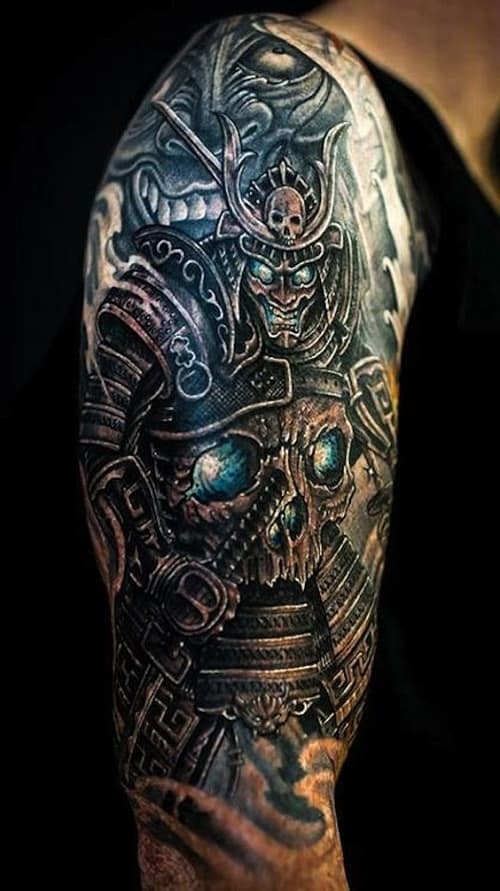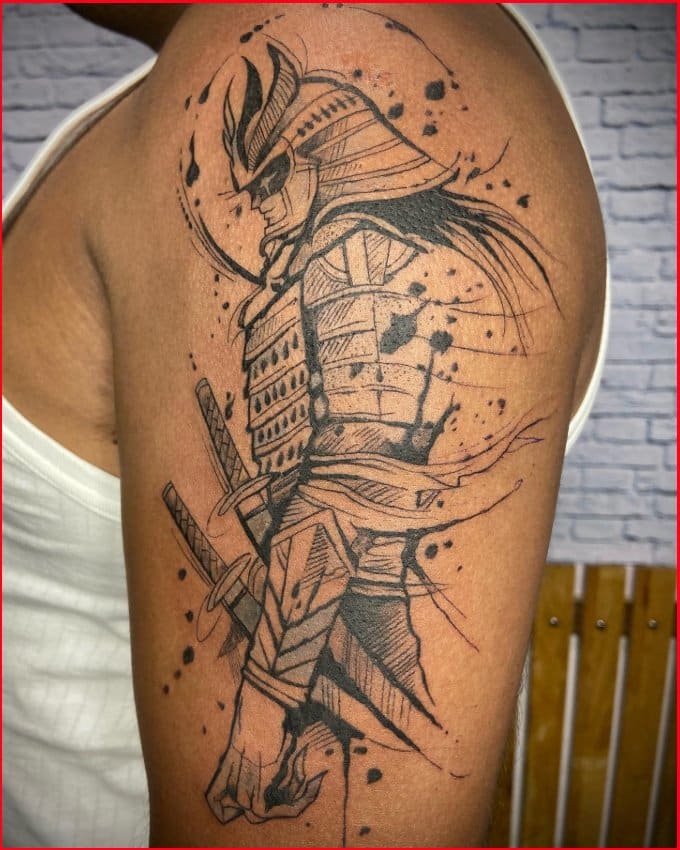Inspire Your Next Japanese Samurai Tattoo with These 10 Designs
Inspire Your Next Japanese Samurai Tattoo with These 10 Designs

Inspire Your Next Japanese Samurai Tattoo with These 10 Designs
Samurai tattoos are a popular choice for men and women alike, thanks to their bold designs and rich symbolism. If you're considering getting a Japanese samurai tattoo, here are 10 designs to inspire you.
1. The Samurai Warrior

The samurai warrior is a classic samurai tattoo design. It typically depicts a samurai in full armor, wielding a sword or spear. This design is a powerful symbol of strength, courage, and honor.
2. The Samurai Helmet
The samurai helmet is another popular samurai tattoo design. It is often depicted in profile, with the characteristic kabuto crest. This design is a symbol of protection and strength.

3. The Samurai Sword
The samurai sword is a powerful symbol in Japanese culture. It is often depicted in a stylized manner, with a long, curved blade. This design is a symbol of power, honor, and discipline.
4. The Samurai Ronin

The samurai ronin is a samurai who has lost his master. This design is often depicted as a lone samurai, wandering the countryside. It is a symbol of freedom, loyalty, and honor.
5. The Samurai Geisha
The geisha is a traditional Japanese entertainer. She is often depicted in a kimono, with a fan and a flower in her hair. This design is a symbol of beauty, grace, and femininity.

6. The Japanese Dragon
The Japanese dragon is a powerful creature in Japanese mythology. It is often depicted as a long, serpentine creature with scales and wings. This design is a symbol of strength, power, and good luck.
7. The Japanese Koi Fish

The Japanese koi fish is a symbol of perseverance and strength. It is often depicted as a koi swimming upstream against a waterfall. This design is a reminder that anything is possible if you set your mind to it.
8. The Japanese Cherry Blossom

The Japanese cherry blossom is a symbol of beauty, fragility, and new beginnings. It is often depicted as a single cherry blossom, or as a branch of cherry blossoms in bloom. This design is a reminder that life is short and precious, and that we should enjoy each moment.

9. The Japanese Wave
The Japanese wave is a symbol of strength, power, and resilience. It is often depicted as a large, crashing wave. This design is a reminder that we can overcome any obstacle if we stay strong and focused.

10. The Japanese Yin Yang


The Japanese yin yang is a symbol of balance and harmony. It is often depicted as a circle, with black and white halves that are intertwined. This design is a reminder that we all have both positive and negative qualities, and that we need to find balance in our lives.
These are just a few of the many possible Japanese samurai tattoo designs. When choosing a design, consider what it means to you and how it will fit into your overall tattoo collection. If you have any questions, be sure to consult with your tattoo artist.

Additional Resources

- The History of Japanese Samurai Tattoos
- The Meaning of Japanese Samurai Tattoos
- The Best Japanese Samurai Tattoo Artists

Traditional Japanese Samurai Tattoo Designs: A Guide
Samurai tattoos are a popular choice for men and women alike, thanks to their striking visuals and rich symbolism. Traditional Japanese samurai tattoo designs often incorporate elements of nature, such as cherry blossoms, waves, and dragons, as well as religious imagery, such as the Buddhist lotus flower.

If you're thinking about getting a samurai tattoo, there are a few things you should keep in mind. First, consider the meaning of the design you choose. Samurai tattoos are often associated with strength, courage, and honor, so it's important to choose a design that resonates with your personal values.
Second, think about the size and placement of your tattoo. Samurai tattoos can be small or large, and they can be placed anywhere on the body. However, it's important to choose a placement that will work well with the design you choose.
Finally, find a talented artist who specializes in Japanese tattooing. A good artist will be able to help you design a custom tattoo that you'll love for years to come.

In this guide, we'll discuss the history of samurai tattoos, explore the different design elements that are commonly used, and provide tips for choosing the right tattoo for you.
History of Samurai Tattoos
The history of samurai tattoos is long and complex. The earliest evidence of tattoos in Japan dates back to the Jomon period (10,000-300 BCE). During this time, tattoos were used for a variety of purposes, including religious rituals, identification, and protection from evil spirits.

By the Heian period (794-1185), tattoos had become increasingly popular among the samurai class. Samurai tattoos were often used to commemorate military victories or to demonstrate loyalty to a particular daimyo (feudal lord).
During the Edo period (1603-1868), tattoos became even more popular among the samurai class. This was due in part to the fact that the Tokugawa shogunate (1603-1868) banned the wearing of swords by samurai, who began to use tattoos as a way to demonstrate their status.

By the end of the Edo period, samurai tattoos had become a symbol of strength, courage, and honor. This tradition continues to this day, and samurai tattoos are still popular among men and women who admire the samurai code of bushido.
Elements of Traditional Japanese Samurai Tattoo Designs
Traditional Japanese samurai tattoo designs often incorporate a variety of elements, including:
- Nature: Cherry blossoms, waves, dragons, and other natural elements are common motifs in samurai tattoos. These elements represent the beauty and power of nature, and they are often used to symbolize the samurai's connection to the natural world.
- Religion: Buddhist and Shinto imagery is also commonly found in samurai tattoos. The lotus flower, for example, is a Buddhist symbol of purity and enlightenment. The dragon, on the other hand, is a Shinto symbol of strength and power.
- Symbols of rank: Samurai tattoos often include symbols of rank, such as the mon (family crest) or the kamon (clan crest). These symbols show the wearer's status and lineage, and they are a way to show respect for one's ancestors.


Tips for Choosing a Traditional Japanese Samurai Tattoo
If you're thinking about getting a samurai tattoo, there are a few things you should keep in mind:

- Consider the meaning of the design you choose. Samurai tattoos are often associated with strength, courage, and honor, so it's important to choose a design that resonates with your personal values.
- Think about the size and placement of your tattoo. Samurai tattoos can be small or large, and they can be placed anywhere on the body. However, it's important to choose a placement that will work well with the design you choose.
- Find a talented artist who specializes in Japanese tattooing. A good artist will be able to help you design a custom tattoo that you'll love for years to come.


Here are some additional tips for choosing a traditional Japanese samurai tattoo:
- Do your research. There are many different resources available online and in libraries that can help you learn about the history and symbolism of samurai tattoos.
- Talk to your artist. Your artist can help you narrow down your options and choose a design that is right for you.
- Take your time. Getting a tattoo is a big decision, so don't rush into it. Take your time and find a design that you love.

Conclusion

Samurai tattoos are a beautiful and meaningful way to express your personal values and beliefs. If you're.